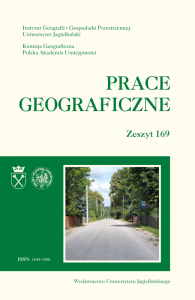Regiony dendroklimatyczne modrzewia europejskiego (Larix decidua Mill.) w Polsce
Dendroclimatic regions of European larch (Larix decidua Mill.) in Poland
Author(s): Norbert Szymański, Sławomir WilczyńskiSubject(s): Environmental Geography
Published by: Wydawnictwo Uniwersytetu Jagiellońskiego
Keywords: tree-ring; radial growth; climate-growth relationship; climate sensitivity; dendrochronology;
Summary/Abstract: The purpose of the study was to determine the dendroclimatic regions in Poland, based on the analysis of the similarity of the annual growth rhythm of trees of 19 European larch populations, which is the reaction of trees to the pressure of the climatic factor. Treering widths were taken as a measure of this reaction. For each population (site), a mean treering chronology was created that covered the period 1957–2016. Its values were converted into incremental indices. Then, 19 indexed chronologies were included in the principal component analysis (PCA) to identify their common features and group them. As a result, three dendroclimatic regions were distinguished, which coincide with the area of lowlands (Pojezierze Południowobałtyckie and Niziny Środkowopolskie), uplands (Wyżyna Krakowsko- -Częstochowska and Wyżyna Małopolska) and mountain areas (the Sudetes and the Western Carpathians). To identify climatic elements that had a significant impact on the size of the radial growth of larch in the dendroclimatic regions, the values of the main components (PC1, PC2, PC3) were correlated with the climatic parameters. Analogously, these analyzes were performed for three regional chronologies which were created by averaging the site indexed chronologies for a given region (group). The size of radial increments of all larch populations was found to be positively affected by low temperature and high rainfall in September in the year preceding growth, as well as high temperature in March and May and high rainfall in July in the year of ring formation. In turn, the high temperature in November of the previous year had a positive effect on the growth of larches growing in the lowlands and uplands and had a negative effect on the growth of larches in the mountains. High temperature and low rainfall in June had a positive effect on the growth of larches from the mountains, compared to those from the lowlands and uplands. Low temperature and high rainfall in October in the previous year and high rainfall in May in the year of ring deposition had a positive effect on the growth of larches in the uplands.
Journal: Prace Geograficzne
- Issue Year: 2022
- Issue No: 169
- Page Range: 69-85
- Page Count: 17
- Language: Polish

